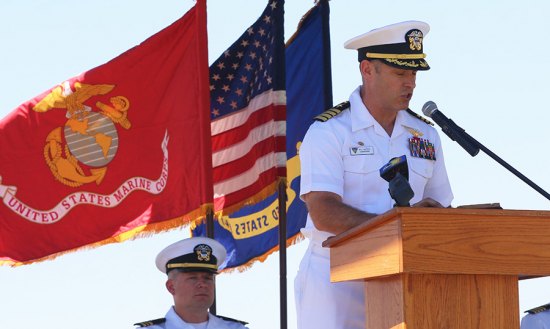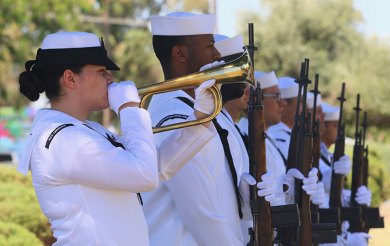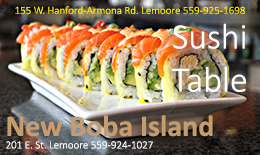NAS Lemoore commemorates Battle of Midway, key naval campaign in World War II
According to base officials, the Navy directs its installations to remember and commemorate the battle due to its historical significance.
About 50 persons were on hand at base headquarters, including a number of veterans who showed up to pay respect to the event.
“We commemorate (The Battle of) Midway every year,” said Public Affairs Spokesperson Lydia Bock. “Last year we did a small in-house event.”
The Battle of Midway is often regarded as the turning point in the Pacific during WW II. It was a decisive battle that shaped the Allied Forces’ balance of power in the Pacific Theater of World War II. From June 4-7, the United States Navy delivered devastating damage to the attacking fleet of the Imperial Japanese Navy.
Capt. William Gotten, Commodore of Strike Fighter Wing Pacific spoke to the small crowd assembled for the event. The Leader has decided to present Gotten’s remarks in full:
The Battle of Midway
Seventy-six years ago, a desperate and furious struggle took place in the waters near the two small, lonely islands of Midway and Sand, in an atoll about 1,300 miles northwest of Hawaii. Today, we remember the Battle of Midway and the brave Americans who answered our Nation’s call.
The Battle of Midway occurred during the first week of June 1942, just six months after Pearl Harbor had been attacked by Japanese forces. Midway was significant in that it changed the tide of the war in the Pacific and ultimately the course of world history. The ultimate American victory at Midway arrested the eastward advancement of Japanese naval forces. However, the weeks leading up to this battle were America’s darkest hours in the Pacific.
The story of the American victory at Midway actually begins in early May with the outcome of a previous naval engagement at the Battle of the Coral Sea. Although considered an American victory in that U.S. Forces prevented the Imperial Japanese Navy from invading Port Moresby and expanding its reach farther into the southern Pacific, the battle exacted a heavy price.
The U.S. Navy lost one of its largest aircraft carriers, USS Lexington, as well as almost 600 Sailors and roughly 70 aircraft. Most importantly, the American victory at the Battle of the Coral Sea forced the enemy into making a decision that would change the entire course of the war in the Pacific.
Despite the heavy resistance at the Battle of the Coral Sea, Japanese forces continued pushing southward to isolate Australia and ultimately deliver a crushing blow to the U.S. Fleet, yet again on Hawaii’s doorstep. Admiral Yamamoto was leading his carrier striking force east to search out and destroy the United States Pacific Fleet, particularly, the American aircraft carriers that had been missed at Pearl Harbor.
His major goal was to occupy the Western Pacific islands, including Midway, thus securing a broad Japanese defensive perimeter and preventing a repeat of the humiliating assault by Doolittle’s Raiders on mainland Japan.
Midway was Yamamoto’s prime objective. He knew now, after the Battle of the Coral Sea, the odds of securing the island were heavily in his favor. The aircraft carrier USS Yorktown had been badly damaged, and USS Lexington had been sunk. Other carriers, USS Enterprise and USS Hornet, had been spotted in the far south Pacific and would not be factored into American resistance forces. In his mind, Midway was his for the taking.
The Japanese Admiral was well-informed on all matters but one: he could not guess that American intelligence officers had enough information, through scouting and reconnaissance reports, to know that an attack on Midway was in-the-making.
Armed with that information, while the Imperial Japanese Navy was planning its attack, urgent calls were going out to Enterprise and Hornet and all available ships to steam for Midway at top speed and for Yorktown to undergo rush repairs on her flight deck, getting her ready for the ensuing battle.
By the end of May, American forces for the protection of Midway consisted of eight cruisers, nineteen submarines, fourteen destroyers, three carriers and a small force of old battleships. Leadership of these forces was consolidated as a single unit under the leadership of Admiral Frank J. Fletcher.
Even with those additions, American forces were still outnumbered. Advancing from the west was one of the greatest enemy fleets ever assembled – more than one-hundred ships, including four carriers, eleven battleships, submarines, cruisers and destroyers were part of this massive Japanese fleet. Following behind this fleet were cargo and transport vessels containing supplies and almost 4,000 invasion troops.
American forces had only three aircraft carriers (Enterprise, Hornet and Yorktown) and a handful of ships and submarines. We had no right to win, and yet we did.
The deaths and destruction surrounding Midway were staggering. At the end of a four-day battle, the U.S. Navy destroyed four enemy carriers, two heavy cruisers, four destroyers and 300 aircraft. These were the same carriers that were present at the infamous attack on Pearl Harbor. Additionally, the Imperial Japanese Navy lost 3,500 lives. This was the first decisive defeat suffered by the Japanese Navy in 350 years.
The price of victory for American forces was 307 lives, 147 aircraft, a destroyer and an aircraft carrier. These tragic losses were a gruesome testament to the horrors of war that echoed around the world. It was the price of victory.
The Battle of Midway was significant because in a single, master-stroke, a battered U.S. Navy and Marine Corps halted the Japanese advance. Our victory is often attributed to the character, courage and audacity of the men who continued to fight, despite the odds. To this day, the American action at Midway stands out as one of the greatest victories in our naval history, abruptly ending Japan’s eastward thrust and turning the tide of the war in the Pacific. There were many heroes at Midway. At the top of the list are Admirals Chester Nimitz, Raymond Spruance and Frank Jack Fletcher, Ensign George Gay, Major Lofton Henderson; Medal of Honor Recipient Captain Richard Fleming and Captain Jack Reid whose sighting of the Japanese made all the difference and turned the battle into the U.S.’s favor. There were the unsung heroes ranging from those who broke the Japanese code in Operation Magic that provided Admiral Nimitz the crucial element of surprise, to those who repaired Yorktown in record time and gave our forces much-needed support.
One such hero is particularly appropriate for us to mention here at NAS Lemoore. Rear Admiral Clarence Wade McClusky Jr. played a pivotal role in the American victory at Midway. He commanded the air group aboard USS Enterprise. At the ripe old age of 40, he was the oldest aviator aboard the ship. Although he had spent most of his career as a fighter pilot, his seniority had garnered him the position as the commander of a bomber group, consisting of scouting squadron VS-6, bombing squadron VB-6 as well as the TDB-1 torpedo bombers of VT-6. On the morning of June 4th, engine problems and flight deck delays prevented the full complement of McClusky’s group from launching on time. Meanwhile, McClusky’s bombers, along with McClusky himself continued circling over the task force, awaiting permission to proceed with their mission…all the while, burning fuel. After more than an hour of waiting, McClusky was cleared to proceed on mission assigned. However, he would have to complete his tasking with only dive-bomber assets, and not as a coordinated attack by bombers and torpedo planes.
McClusky’s group of 32 dive-bombers flew southwest toward previously determined coordinates, hoping to find the Japanese fleet. However, it was a long flight and the previous hold-up had burned up most of the group’s fuel. Some pilots even commented that this was going to be a “one-way flight.” When McClusky arrived on-station in the general area where he expected to find Imperial Japanese carriers, he saw nothing below him but empty ocean.
Even though he and his squadron were dangerously low on fuel, they continued to search, as the American element of surprise depended on what they found. He turned the formation slightly to the right and flew due west for 35 miles. He then turned right again to the northwest, intending to conduct a standard box search. He scanned the horizon eagerly for the sign of any surface ships, his binoculars “practically glued,” to his eyes.
Two of his bomber pilots ran out of fuel and ditched in the water. Finally, after roughly 30 minutes of searching, well north of the plotted intercept position, McClusky spotted a single ship, proceeding northward at great speed, its bow wave making a broad wake that looked for all the world like a white arrow painted on the surface of the sea.
McClusky guessed at once that it was a laggard from the Kido Butai and, using that V-shaped bow wave as a guide, he altered course to follow the arrow just east of due north. Ten minutes later, he saw dark specks on the horizon ahead of him. As he flew closer, the specks resolved themselves into surface ships. He had found the Japanese carrier group Kido Butai.
As McClusky and his squadron approached the Kido Butai that morning, they saw so many valuable targets below them that there was confusion about which to attack. The nearest target was the big carrier Kaga; five miles to its right and a few miles ahead of it was the Japanese flagship Akagi.
McClusky, who had spent most of his career as a fighter pilot, approached the situation with typical American straightforwardness. He saw the two carriers not as near and far, but as left and right. He broke radio silence to order the two squadron leads to take the carrier “on the left” and the carrier “on the right.”
The order was never received and both squadrons prepared to dive on Kaga. The Americans had gained a crucial advantage by arriving over Kido Butai at a critical moment; now the confusion in assigning targets threatened to waste it.
Twenty-seven American aircraft dove on Kaga. They plastered it with bombs. Within minutes, it was a smoking wreck. However, only three aircraft remained for the attack on Akagi. They proceeded toward Akagi in a shallow V formation. It was “a calm placid morning,” as one pilot recalled, and he remembered thinking that it felt just like a “regular individual battle practice drill.” As they dove from 14,000 feet, one of the pilots put his bomb-sight in the middle of Akagi’s flight deck, just forward of its small island, and released his bomb at about 1,500 feet. The other two pilots followed suit.
The first 1,000-pound bomb struck square on Akagi’s flight deck and penetrated to its crowded hangar deck. The immediate damage was extensive, but the secondary damage was catastrophic. Akagi’s hangar deck was crowded with 18 big “Kate” torpedo bombers, all of them with fuel tanks filled to the top and armed with 1,870-pound Type 91 torpedoes.
Other ordnance lay on the carts and on the racks along the bulkhead. Within minutes, that ordnance began to cook off, and once the explosions started, the aviation fuel from the wrecked planes fed the fires. The error that sent 27 of McClusky’s 30 planes against the same carrier turned out not to matter: both the Kaga and Akagi were burning out of control.
It was the bold decision of Wade McClusky to continue searching with an almost empty fuel tank that led to the discovery of the Japanese Fleet. The story of American Sailors having the moxie to continue bringing the fight to the enemy was not unique to Midway. Hundreds of others, whether they were flag officers or plane pushers, played an important role in the victory at Midway. To be sure, some amount of luck was involved – but sometimes bold and courageous men make their own luck.
The service members who fought in WWII were not that different from the men and women in today’s Navy. They too came from small towns, big cities, farms and suburbs. The summer before Midway, their minds were anywhere but that lonely atoll in the Pacific.
The challenges they faced were unfair and overwhelming…but war is not fair. These men soon realized their hidden strengths, made evident by the demands of war. They knew it was not enough to give their best. Victory was the only option.
At the Battle of Midway, the single element that mattered more than anything else was the fighting spirit of the American Sailors and Marines. It was that spirit that spurred them on through insurmountable danger, hardship, blood and death, to the goal of ultimate success. Never in our 200-plus year-history have American Bluejackets been called upon to endure more, given less. We are right to single-out their courage. It was that courage, there on that day, that secured a much-needed victory.
That fighting spirit is at the core of the Battle at Midway. It was the character of the American Sailor that turned the tide of war. Though weapons and tactics change, it was their fundamental beliefs and willingness to defend them that prevailed at Midway. It was patriotism, love of country and a desire to do what was right by their country that drove these men to victory.
As we examine today’s Navy, our greatest asset is the courage and commitment of our service men and women. Take a moment to remember Midway. Think of those who were serving that day. They had families and loved-ones back home, yet they continued into the heart of conflict. Think of the brave aircrew who climbed into aircraft on the flight decks of Enterprise, Yorktown and Hornet — the weight of ensuring American freedom on their shoulders.
In those circumstances, with so many odds against them, what forged their will to face such a strong enemy? Courage of course…but it was also their shipmates. Service is a sacred bond and friends fight for friends as well as for country.
The recent losses at Coral Sea and Pearl Harbor also developed resolve deep into those Sailors’ minds and hearts. Whatever their focus on June 4, the mission was clear: America needed to win, and they needed to win using fewer carriers, older aircraft and scarce ships.
Some of the bravest action at Midway was performed by the men of Torpedo Squadron 8. From the beginning, VT-8 faced overwhelming odds. The pilots were new, and their aircraft were old. Because several were boot ensigns, they had to train for fighting in a war while actually fighting the war. For many of them, the Battle of Midway was the first time they carried a torpedo on an aircraft, off a ship, or even seen any of that done.
Ensign George Gay later said, “quite a few of us were a little bit skeptical and leery, but we’d seen Doolittle and his boys …they hadn’t seen a carrier before and they took the B-25s off. So, we figured by golly if they can do it, well we could too.”
With that picture in their minds and willingness in their hearts, VT-8 launched from Hornet with orders to drop torpedoes on as many ships in the Japanese fleet as possible.
Lieutenant Commander John Waldron led the way. He saw the enemy carriers just as he was running low on fuel. He asked permission to withdraw and refuel before attacking, but the reply was negative. Waldron was ordered to attack at once. With little fuel and no cover from fighters, he flew out in front and approached the enemy at low altitude — in plain view of the Japanese and their Zeros. With just nine miles to go, the Zeros engaged. The Douglas TBD Devastators moved slowly, toward the heart of the fleet — an act later compared to “riding in a hearse.”
Before the torpedo planes could make a single hit on an enemy carrier, Zeros shot down every plane in Torpedo Squadron 8. Fifteen planes fell into the sea. Twenty-nine men were lost. Only Ensign Gay survived.
VT-8 did not succeed in their mission that day, but the threat of their attack did make enemy carriers maneuver, and they did draw the Zeros in low, distracting the enemy with their sacrifice — precious minutes that opened opportunity for the next wave of torpedo planes and bombers.
The dive bombers did succeed, hitting Japanese carriers just as they prepared to launch refueled planes. The enemy later reported, “We were unable to avoid the dive bombers because we were so occupied in avoiding the torpedoes.”
“We were unable …”
Those are words of surrender, and for the U.S. – victory.
The Sailors at Midway gave everything they had with what they had. As one veteran put it, “those guys had the guts to fly those planes. They did what they could. That’s the American spirit.”
They say Midway turned the tide of the Pacific War, but it was not the location — it was the Sailors, Marines and Airmen who took hold of the situation, and with raw determination and grit made the odds turn in our favor — inch by inch. It was an all-hands effort by the ships’ engine room Sailors, gunner’s mates and squadron maintenance crews. It took the sacrifice of other torpedo squadrons from Yorktown and Enterprise. USS Hammann — and Yorktown herself — were also lost.
At the time, nobody knew the outcome of that battle or how long the war would last. Midway was not halfway. It was just the beginning of a long march across the Pacific toward peace.
As Walter Lord put it, when referring to the actions of those at the Battle of Midway:
“They had no right to win, yet they did, and in doing so they changed the course of a war. Even against the greatest of odds, there is something in human spirit — a magic blend of skill, faith and valor — that can lift men from certain defeat to incredible victory.”
One thing is certain: The Sailors, Marines, Soldiers and Airmen of this generation are just as courageous and capable as those of the Greatest Generation. The fight for freedom goes on.
May God bless those who returned, those who did not and the families who love them still.
Navy News
- For fourth year in a row, Stratford Elementary School welcomes Sandridge Partners who awards scholarships to 8th graders
- West Hills College Chancellor, Dr. Kristin Clark, announces her retirement, effective July 2024
- West Hills College officials host groundbreaking for new Lemoore Visual Arts and Applied Science Building in Lemoore
- West Hills College Lemoore to hold groundbreaking for new Visual Arts & Applied Sciences Building on December 1
- West Hills College Coalinga and Lemoore campus vie for 2025 Aspen Prize for college excellence
- Mary Immaculate Queen School's annual Fall Festival, held Sunday, Oct. 1, greets hundreds of local guests
_0.jpg)

.jpg)





